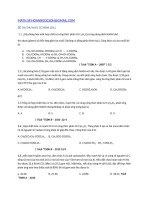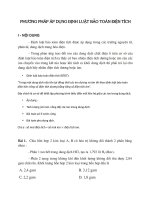E negotiation systems a theoretical framework and empirical investigation
Bạn đang xem bản rút gọn của tài liệu. Xem và tải ngay bản đầy đủ của tài liệu tại đây (2.16 MB, 292 trang )
E-NEGOTIATION SYSTEMS: A THEORETICAL
FRAMEWORK AND EMPIRICAL INVESTIGATION
YANG YINPING
B.Comp.(Hons.), NUS
A THESIS SUBMITTED
FOR THE DEGREE OF DOCTOR OF PHILOSOPHY
DEPARTMENT OF INFORMATION SYSTEMS
NATIONAL UNIVERSITY OF SINGAPORE
2007
i
ACKNOWLEDGEMENTS
I would like to express my sincere gratitude to the following gentlemen and ladies who have
helped me in one way or another in the culmination of this dissertation.
First of all, I would like to thank my thesis supervisor, A/P John Lim, for his excellent guidance,
support and constant encouragement throughout the entire duration of my Ph.D. journey. Prof.
Lim has immensely enlightened me in the field of IS research and has given me much spirited
inspirations on all my academic pursuits throughout the years.
My earnest appreciation goes to my thesis evaluators, A/P Chan Hock Chuan and Dr. Xu Yun-Jie,
for their very valuable advices and encouragement along the way.
I’m very much grateful for my peer schoolmates, Miss Zhong Yingqin, Ms. Chen Yao, Miss Li
Xue, Ms. Wang Zhen, and Ms. Guo Xiaojia for their wonderful collaboration in the conduct of
empirical studies. I thank all the participants who were involved in the series of experiments and
the field study.
To all the professors, colleagues and schoolmates in the department who have made my Ph.D. life
a fruitful and memorable experience.
Last but not least, my heartfelt gratitude to my dearest parents for their utmost love and my
husband, Mr. Chen Zhiwei, for his ever-lasting love, inspiration, and faith with me to keep me
going in spite of all the challenges, difficulties and time constraints involved. I sincerely thank
them for giving me their warmest encouragement and support throughout my doctoral endeavor.
ii
TABLE OF CONTENTS
ACKNOWLEDGEMENTS i
TABLE OF CONTENTS ii
SUMMARY viii
LIST OF TABLES x
LIST OF FIGURES xii
CHAPTER 1 INTRODUCTION 1
1.1 BACKGROUND AND MOTIVATION 1
1.2 RESEARCH SCOPE AND OBJECTIVES 4
1.3 DISSERTATION OUTLINE 6
CHAPTER 2 LITERATURE REVIEW ON NEGOTIATION 8
2.1 NEGOTIATION 8
2.2 THEORETICAL MODELS OF NEGOTIATION 9
2.3 NEGOTIATION DYNAMICS 12
2.3.1 Task Characteristics 13
2.3.1.1 Goals and Strategies 13
2.3.1.2 Issues and Interests 15
2.3.1.3 Conflict of Interests 16
2.3.1.4 Negotiation Power 17
2.3.1.5 Time Pressure and Deadline 19
2.3.2 Negotiator(s) Characteristics 19
2.3.2.1 Gender 20
2.3.2.2 Personality 21
2.3.2.3 Motivation 21
2.3.2.4 Experiences 22
2.3.2.5 Number of Negotiators 22
2.3.2.6 Relationships 23
2.3.2.7 Cultural Differences 24
2.3.3 Negotiation Processes 26
2.3.3.1 Cognition and Perception 26
2.3.3.2 Communication and Language 27
2.3.3.3 Third Party Intervention 28
2.3.4 Political and Cultural Environment 30
CHAPTER 3 LITERATURE REVIEW ON E-NEGOTIATIONS 32
3.1 CHRONOLOGICAL EVOLUTION OF E-NEGOTIATIONS RESEARCH 32
3.1.1 Early 1960s to 1980s: “Era” of Decision Support 33
3.1.2 Late 1980s to 1990s: “Era” of Laboratory-Based NSS Studies 34
3.1.3 Late 1990s to Now: “Era” of E-Negotiations and Automated Negotiation 37
iii
3.2 THEORETICAL FOUNDATION FOR NSS/ENS 39
3.2.1 Principled Negotiation 39
3.2.1.1 Stumbling Blocks to Negotiations 39
3.2.1.2 Guidelines and Principles 41
3.2.1.3 The IT Solution of Negotiation Problem 42
3.2.2 Theory of NSS 45
3.2.2.1 Two Components of an NSS 45
3.2.2.2 Scope of the Theory 47
3.2.2.3 Related Experimental Studies 47
3.3 SUMMARY OF VARIABLES USED IN NSS/ENS LITERATURE 50
CHAPTER 4 THE THEORETICAL FRAMEWORK 52
4.1 THE INDEPENDENT VARIABLE – ENS FUNCTIONALITIES 53
4.1.1 Classification of ENS Functionalities 53
4.1.2 Category I: Group Decision Support 57
4.1.2.1 Overview of Category I System Prototypes 58
4.1.2.2 Design Objectives 60
4.1.2.3 Sub-Classification of DSS Support 61
4.1.3 Category II: Multimedia Communication Support 64
4.1.3.1 Overview of Category II System Prototypes 65
4.1.3.2 Design Objectives 67
4.1.3.3 Sub-Classification of Communication Support 67
4.1.4 Category III: Agent-Based Automation 70
4.1.4.1 Overview of Category III System Prototypes 71
4.1.4.2 Design Objectives 71
4.1.4.3 Sub-Classification of Agent-Based Automation 74
4.2 THE DEPENDENT VARIABLES - NEGOTIATION PROCESS AND OUTCOMES 77
4.2.1 Economic Perspectives 78
4.2.1.1 Efficiency 79
4.2.1.2 Fairness 85
4.2.1.3 Time to Settlement 89
4.2.2 Social-Psychological Perspectives 90
4.2.2.1 Attitudes towards the Negotiation Settlement 90
4.2.2.2 Attitudes towards the Negotiation Process 92
4.2.2.3 Attitudes towards the System 92
4.3 RESEARCH PROPOSITIONS 96
4.3.1 Main Effects of ENS Functionalities 96
4.3.1.1 Effects of Decision Support Tools 97
4.3.1.2 Effects of Communication Media 104
4.3.1.3 Effects of System Intelligence Levels 109
4.3.2 Moderating Effects of Levels of Conflict 110
4.4 OUTLINE OF ENS EXPERIMENTAL STUDIES 111
CHAPTER 5 EFFECTS OF PRE-NEGOTIATION AND NEGOTIATION SUPPORT FOR
UNSTRUCTURED NEGOTIATION TASK (CATEGORY I SYSTEM) 113
5.1 THE RESEARCH MODEL AND HYPOTHESES 113
iv
5.1.1 The Research Model 113
5.1.2 Hypotheses 114
5.1.2.1 Gain 115
5.1.2.2 Contract Balance 116
5.1.2.3 Time to Settlement 117
5.2 EXPERIMENTAL DESIGN 117
5.2.1 Independent Variables 118
5.2.2 Dependent Variables 119
5.2.3 Negotiation Task 121
5.2.4 Experiment Procedure 121
5.3 DATA ANALYSIS AND RESULTS 123
5.4 DISCUSSION 124
5.4.1 Gain 124
5.4.2 Contract Balance 126
5.4.3 Time to Settlement 128
5.5 CONTRIBUTIONS AND LIMITATIONS 129
CHAPTER 6 EFFECTS OF NSS AND MULTILINGUAL SUPPORT FOR ENGLISH-
CHINESE NEGOTIATORS (CATEGORY I AND II SYSTEMS) 131
6.1 THE RESEARCH MODEL AND HYPOTHESES 131
6.1.1 The Research Model 131
6.1.2 Hypotheses 132
6.1.2.1 Individual Outcome, Joint Outcome and Contract Balance 132
6.1.2.2 Time to Settlement 134
6.1.2.3 Satisfaction with Settlement 135
6.2 EXPERIMENTAL DESIGN 135
6.2.1 Independent Variables 136
6.2.2 Dependent Variables 138
6.2.3 Negotiation Task 138
6.2.4 Experiment Procedure 139
6.3 DATA ANALYSIS AND RESULTS 140
6.4 DISCUSSION 142
6.4.1 Individual Outcome 142
6.4.2 Joint Outcome 143
6.4.3 Contract Balance 144
6.4.4 Time to Settlement 145
6.4.5 Satisfaction with Settlement 146
6.5 CONTRIBUTIONS AND LIMITATIONS 147
v
CHAPTER 7 EFFECTS OF DECISION SUPPORT AND CONFLICT LEVEL FOR
NEGOTIATIONS VIA VIDEOCONFERENCING (CATEGORY I AND II SYSTEMS)…
…………………………………………………………………………………………… 150
7.1 THE RESEARCH MODEL AND HYPOTHESES 150
7.1.1 The Research Model 150
7.1.2 Hypotheses 151
7.1.2.1 Joint Outcome and Contract Balance 151
7.1.2.2 Time to Settlement 153
7.1.2.3 Confidence with Solution 153
7.1.2.4 Perceived Collaborative Atmosphere 154
7.2 EXPERIMENTAL DESIGN 154
7.2.1 Independent Variables 155
7.2.2 Dependent Variables 158
7.2.3 Negotiation Task 158
7.2.4 Experiment Procedure 159
7.3 DATA ANALYSIS AND RESULTS 160
7.4 DISCUSSION 161
7.4.1 Joint Outcome 161
7.4.2 Contract Balance 162
7.4.3 Time to Settlement 163
7.4.4 Confidence with Solution 164
7.4.5 Perceived Collaborative Atmosphere 164
7.5 CONTRIBUTIONS AND LIMITATIONS 165
CHAPTER 8 EFFECTS OF AUTOMATED NEGOTIATION SUPPORT AND
CONFLICT LEVEL INVOLVING INTELLIGENT AGENTS (CATEGORY I, II AND III
SYSTEMS) 167
8.1 THE RESEARCH MODEL AND HYPOTHESES 168
8.1.1 The Research Model 168
8.1.2 Hypotheses 169
8.1.2.1 Joint Outcome and Contract Balance 169
8.1.2.2 Time to Settlement 171
8.1.2.3 Satisfaction with Settlement 172
8.1.2.4 Perceived Collaborative Atmosphere 173
8.1.2.5 Perceived Control 174
8.1.2.6 System Anxiety 176
8.2 EXPERIMENTAL DESIGN 176
8.2.1 Independent Variables 177
8.2.2 Dependent Variables 181
8.2.3 Negotiation Task 182
8.2.4 Experiment Procedure 183
8.3 DATA ANALYSIS AND RESULTS 183
vi
8.3.1 Control and Reliability Tests 184
8.3.2 Analysis of Variance Tests and Hypotheses Testing 186
8.4 DISCUSSION 188
8.4.1 Joint Outcome and Contract Balance 188
8.4.2 Time to Settlement 189
8.4.3 Satisfaction with Settlement 190
8.4.4 Perceived Collaborative Atmosphere 192
8.4.5 Perceived Control 193
8.4.6 System Anxiety 194
8.5 CONTRIBUTIONS AND LIMITATIONS 195
CHAPTER 9 THE CURRENT STATE AND FUTURE OF E-NEGOTIATIONS IN E-
MARKETPLACES 197
9.1 OVERVIEW OF COMMERCIAL NEGOTIATION SERVICES AND PACKAGES 198
9.2 E-NEGOTIATIONS IN B2B E-MARKETPLACES 201
9.3 AN EXPLORATORY STUDY ON PERCEPTIONS OF E-NEGOTIATIONS IN CHINA’S B2B
E-MARKETPLACES 204
9.3.1 Background 205
9.3.2 Research Approach 207
9.3.3 Preliminary Results 208
9.3.3.1 System Characteristics and Perceived System Effectiveness 209
9.3.3.2 Negotiator’s Characteristics and Perceived System Effectiveness 210
9.3.3.3 Institutional Factors and Trust in e-Negotiation systems and Trading Partners 211
9.3.3.4 The Moderating Role of Situational Factors 213
9.3.3.5 Determinants of Adoption Intention of e-Negotiations 214
9.3.4 Discussion and Remarks 215
CHAPTER 10 CONCLUDING REMARKS 216
10.1 SUMMARY OF FINDINGS 216
10.2 IMPLICATIONS AND RECOMMENDATIONS 217
10.3 LIMITATIONS AND FUTURE RESEARCH 220
BIBLIOGRAPHY 222
APPENDIX A EXPERIMENTAL MATERIALS A-1
A.1 GENERAL INSTRUCTIONS A-1
A.2 PUBLIC INFORMATION ON THE BACKGROUND NEGOTIATION TASK A-1
A.3 PRIVATE INFORMATION ON PAYOFF POINT STRUCTURE AND BATNA A-3
A.4 USER MANUAL ON THE THREE PRONEG SYSTEMS A-7
A.5 PRE-NEGOTIATION QUESTIONNAIRE A-10
A.6 NEGOTIATION MEMO A-11
vii
A.7 POST-NEGOTIATION QUESTIONNAIRE A-11
APPENDIX B MORE STATISTICAL OUTPUTS FOR EXPERIMENT 4 (CHAPTER 8)
…………………………………………………………………………………1
B.1 VALIDATION TESTS ON CONTROLLED VARIABLES B-1
(1) Age, Experiences and Computer Efficacy B-1
(2) Gender B-5
B.2 FACTOR ANALYSIS AND RELIABILITY TESTS B-6
B.3 DESCRIPTIVE STATISTICS AND PROFILE PLOTS B-8
(1) Descriptive Statistics (Mean and Standard Deviation) B-8
(2) Profile Plots B-11
B.4 TWO-WAY MANOVA TESTS OUTPUTS ON DEPENDENT VARIABLES B-15
(1) Tests of Homogeneity of Variances B-15
(2) Results of Two-Way MANOVA Tests B-16
B.5 HYPOTHESES TESTING B-17
(1) Results of Two-Way MANOVA Tests – Contrasts and Post-Hoc Analysis B-18
(2) Results of One-Way ANOVA Tests under Different Conflict Level Treatments – Contrasts and
Post-Hoc Analysis B-21
APPENDIX C GUIDES AND SUMMARY OF INTERVIEWS C-1
C.1 FACILITATIVE GUIDES TO INTERVIEW C-1
C.2 SUMMARY OF INTERVIEWS C-2
viii
SUMMARY
The process by which two or more parties with conflict of interests reach a compromise or
agreement is a much researched topic of many disciplines, which is referred by economists as a
market mechanism or “negotiation”. Recent advancements in information and communication
technologies (ICTs) have triggered a surge of interest in the computerization of negotiations. The
computer-based negotiation systems take many forms in terms of their design goals, the
underlying technologies and system architectures, collectively studied in the broad field of e-
Negotiation Systems (ENSs) research. In contrast to the ever-growing attention, the awareness
and widespread adoption of ENSs still seem to be slow-paced in the industry. This dissertation is
highly motivated to contribute towards the successful design and use of advanced negotiation
support technologies as an endeavor to shed light on ENS-application in organizations, through
the development of a theoretical framework and subsequent empirical investigation. In this
endeavor, the effectiveness and efficacy of differing ENS functionalities are evaluated by a dual
theoretical lens employing the economic, game-theoretic perspective of negotiation outcomes in
terms of efficiency and fairness, as well as the social-psychological measures of negotiation
process and outcomes such as negotiators’ satisfaction and perceived collaboration. Furthermore,
we also examine how the task characteristics interplay with the different configurations of system
design in affecting negotiations.
This dissertation attempts to address three appealing research issues centered on ENSs: 1) the
conceptual classification of key ENS functionalities incorporating decision support, multimedia
communication support and agent-based automation, 2) the systematic examination of the effects
of different ENSs, and 3) elucidating the practitioners’ perceptions of e-Negotiations in B2B e-
marketplaces. A theoretical research framework is proposed which triangulates the effects of ENS
functionalities with respect to both economic and social-psychological measures of the
negotiation process and outcome. Based on this framework, system prototypes featuring key ENS
ix
functionalities are developed, followed by a series of experimental studies utilizing factorial
design. Together, our findings suggest that ENS technologies have significant effectiveness and
efficacy when situated in appropriate settings. Among others, pre-negotiation support, decision
support and multilingual support tools are shown to have positive impacts in enhancing
negotiators’ joint outcomes. Compared to decision support tools, the effects of agent-based
negotiation systems differ significantly in terms of negotiators’ satisfaction with negotiated
settlement and on their perceived control towards the system. In addition, a field study is carried
out in a B2B e-market context with the aim of inquiring potential ENS-users’ perceptions of e-
Negotiation technologies. The findings highlight important situational factors leading to ENS
adoption intentions and suggest positive opportunities in jointly engaging diverse forms of e-
Negotiation technologies in B2B e-market growth. The dissertation ends by envisioning the
outlook of e-Negotiations and articulating directions for future research.
x
LIST OF TABLES
Table 3-1. Major Stumbling Blocks to Successful Negotiations and NSS solutions (Adapted from
Foroughi et al., 1995) 43
Table 4-1. Illustrative Prototypes for Category I Systems 59
Table 4-2. Illustrative Prototypes for Category II Systems 66
Table 4-3. Illustrative Prototypes for Category III Systems 71
Table 5-1. Summary of ANOVA Results 123
Table 5-2. Summary of Results on Hypotheses Testing (Experiment 1) 124
Table 6-1. Summary of ANOVA results 141
Table 6-2. Summary of Results on Hypotheses Testing (Experiment 2) 141
Table 7-1. Summary of ANOVA Results 160
Table 7-2. Summary of Results on Hypotheses Testing (Experiment 3) 161
Table 8-1. Summary of Two-Way MANOVA Results 187
Table 8-2. Summary of Results on Hypotheses Testing (Experiment 4) 187
Table 9-1. Commercial Negotiation Services and Packages 199
Table 9-2. Potential Value-Added Roles of Intermediaries 202
Table A-1. Items for Perceived Collaborative Atmosphere and Satisfaction A-11
Table A-2. Items for Perceived control A-12
Table A-3. Items for System anxiety A-12
Table B-1. Descriptive Statistics for Age, Past Experiences and Computer Self-efficacy across
Treatment Groups B-1
Table B-2. Two-Way ANOVA Results on Age, Past Experiences and Computer Self-efficacy B-3
Table B-3. Results of Two-Way MANCOVA Tests Using Age as Covariance B-4
Table B-4. Frequencies of Male and Female Subjects across Treatment Groups B-5
Table B-5. Mann-Whitney U and Jonckheere-Terpstra Tests Results on Gender B-5
Table B-6. Exploratory Factor Analysis - Rotated Component Matrix B-6
Table B-7. Confirmatory Factor Analysis - Rotated Component Matrix B-7
Table B-8. Results of Reliability Tests B-8
Table B-9. Descriptive Statistics for Dependent Variables across Treatment Groups B-8
Table B-10. Tests of Homogeneity of Variances - Levene's Test of Equality of Error Variances
…B-15
Table B-11. Results of Two-Way MANOVA Tests – Tests of Between-Subjects Effects B-16
Table B-12. Results of Two-Way MANOVA Tests – Contrast Results (K Matrix) B-18
Table B-13. Results of Two-Way MANOVA Tests – Post-Hoc Tests B-19
xi
Table B-14. Tests of Homogeneity of Variances under Low Conflict - Levene's Test of Equality
of Error Variances B-21
Table B-15. Results of One-Way MANOVA Tests under Low Conflict– Tests of Between-
Subjects Effects B-21
Table B-16. Results of One-Way MANOVA Tests under Low Conflict– Results of Two-Way
ANOVA Tests – Post-hoc Tests B-22
Table B-17. Tests of Homogeneity of Variances under High Conflict – Levene's Test of Equality
of Error Variances B-23
Table B-18. Results of One-Way MANOVA Tests under High Conflict – Tests of Between-
Subjects Effects B-23
Table B-19. Results of One-Way MANOVA Tests under High Conflict – Contrast Results (K
Matrix) B-23
Table C-1. Summary of Interviews C-2
xii
LIST OF FIGURES
Figure 2-1. An Overview of Negotiation Dynamics 13
Figure 2-2. Dual Concern Model (Adapted from Pruitt and Rubin, 1986) 14
Figure 2-3. Four Forms of Third-Party Intervention (Adapted from Sheppard, 1984) 28
Figure 3-1. Summary of Variables in ENS Literature 51
Figure 4-1. The Theoretical Framework 53
Figure 4-2. ENS Architecture Focused on Group Decision Support 57
Figure 4-3. The Three Stages of Negotiation 62
Figure 4-4. ENS Architecture Focused on Multimedia Communication Support 65
Figure 4-5. ENS Architecture Focused on Agent-Based Automation 71
Figure 4-6. Pareto Efficiency 80
Figure 4-7. Pareto Efficiency and Joint Utility 82
Figure 4-8. Nash Bargaining Solution 86
Figure 4-9. Nash Solution and Contract Balance 88
Figure 4-10. Using Distance to Nash Solution as Fairness Measure 89
Figure 4-11. An Exploration of the Concept of Perceived Control in IS 94
Figure 5-1. The Research Model 114
Figure 5-2. Experimental Design (Experiment 1) 118
Figure 6-1. The Research Model 132
Figure 6-2. Experimental Design (Experiment 2) 136
Figure 6-3. The Bilingual User Interface 137
Figure 6-4. The Interaction Effect of NSS and Multilingual Support on Contract Balance 144
Figure 7-1. The Research Model 151
Figure 7-2. Experimental Design (Experiment 3) 155
Figure 7-3. Alternative Evaluator - Score for the Alternative Evaluated 156
Figure 7-4. Alternative Generator - Three Contract Alternatives Generated 156
Figure 8-1. The Research Model 168
Figure 8-2. Experimental Design (Experiment 4) 177
Figure 8-3. Main Page of the Level-1 System 178
Figure 8-4. Main Page of the Level-2 System 179
Figure 8-5. Main Page of the Level-3 System 180
Figure 9-1. ENS Architecture for Negotiations in e-Marketplaces 197
Figure 9-2. Many-to-Many B2B Models and Their Characteristics (Turban et al., 2002) 204
xiii
Figure 9-3. Proposed Research Framework for ENS Adoptions 209
Figure B-1. Profile Plots for Joint Outcome B-11
Figure B-2. Profile Plots for Contract Balance B-12
Figure B-3. Profile Plots for Time to Settlement B-12
Figure B-4. Profile Plots for Satisfaction with Settlement B-12
Figure B-5. Profile Plots for Satisfaction with Settlement (Perceived Efficiency) B-13
Figure B-6. Profile Plots for Satisfaction with Settlement (Perceived Fairness) B-13
Figure B-7. Profile Plots for Perceived Collaborative Atmosphere B-13
Figure B-8. Profile Plots for Perceived Control (All Dimensions) B-14
Figure B-9. Profile Plots for Perceived Control (Cognitive Control Dimension Only) B-14
Figure B-10. Profile Plots for Perceived Control (Decisional and Behavioral Control Dimensions
Only) B-14
Figure B-11. Profile Plots for System Anxiety B-15
Chapter 1 Introduction
1
1 CHAPTER 1 INTRODUCTION
1.1 BACKGROUND AND MOTIVATION
Bargaining and negotiation has long been a topic of interest to economists, social scientists,
psychologists and organizational behavior researchers. Being common in the business and social
world, negotiation is also a rather complex task and its success is dependent on a variety of
factors. Weak information processing capacities and capabilities, cognitive biases, and socio-
emotional problems associated with human negotiators often hinder the achievement of optimal
negotiations (Foroughi and Jelassi, 1990; Foroughi et al., 1995). These “stumbling blocks” to
successful negotiation have led researchers to pursue computer-supported negotiations in the
form of Negotiation Support Systems (NSSs) since the 1990s. Rather than considering
negotiation as an “art”, NSSs stress a “scientific” approach to the negotiation process. This
“scientific” approach (Raiffa, 1982) refers to a systematic analysis of problem solving. In the
realm of negotiation, the focus of the analytical approach is on optimizing the outcomes for both
parties and achieving a win-win solution rather than on specific strategies, tactics, and maneuvers,
which will allow one party to “beat” the other. Early research on NSSs has primarily focused on
two key technological aspects: (1) group decision and/or conflict resolution models to help
negotiators reduce discord and increase the chances of reaching consensus, and, (2) providing
rich communication media to enhance communication exchange between negotiators (Bui and
Shakun, 1997).
With the advance of information and communication technologies (ICTs) over the years, the
notion of NSS has apparently evolved. Automated negotiations using advanced agent-based
technologies have become an increasingly important area of Artificial Intelligence (AI) research
(Sycara, 1990; Huang and Sycara, 2002; Li and Cao, 2004). Furthermore, with the globalization
Chapter 1 Introduction
2
of the world’s economy as well as the growth of e-commerce, an increasing number of business
activities are going online. Negotiation, as one of the key activities of business transaction in the
marketplace, has to be effectively and efficiently supported by mechanisms such as process
facilitation and automation. Compared to the traditional view of NSS which focuses on
supplementing face-to-face negotiations, web-based systems deployed over the Internet are
designed to support and/or automate online negotiation activities. These systems are thus
collectively referred to as e-Negotiation Systems, or ENSs (Braun et al., 2006; Goh et al., 2000;
Kersten, 2003; Strobel and Weinhardt, 2003).
More recently, the development and evolution of B2B e-commerce has demonstrated great
potential for applying e-Negotiation technologies to online markets. In today’s growing e-
marketplaces, intermediaries match tens of thousands of small and medium size enterprises
(SMEs) globally, thus opening doors for global buyers and sellers to interact and gain access to
previously unattainable foreign markets. This has triggered awareness of a number of new issues
related to e-Negotiations which have not been addressed adequately in existing literature. While
both researchers and practitioners have come to realize the potential contributions and
commercial values of “negotiated e-commerce” (Moai.com, 2000), it is just as critical to
understand the complications behind the possible success of e-Negotiations. How the exact nature
of negotiation and the ever-changing contextual environment interplay with various forms of e-
Negotiation technologies have become compelling and important issues.
There are two intertwining themes throughout this dissertation: the various forms of e-
Negotiation technologies that assume different roles in supporting negotiations, and the contexts
in which the theoretical and empirical investigations take place. In other words, this dissertation
makes attempts to investigate the joint effects of technological artifacts and contextual factors by
addressing a few key arenas which impose contemporary, noteworthy and contextual challenges
Chapter 1 Introduction
3
to ENS research. This doctoral dissertation is concerned with theoretical and empirical work
incorporating the following arenas.
The first arena deals with the need to provision effective support for all stages of negotiation. In
existing literature, tasks employed in many NSS laboratory studies (e.g., Jones, 1998; Foroughi et
al., 1995; Delaney et al., 1997; Goh et al., 2000) are largely structured with clearly-defined issues
and values for the negotiation task. The common assumption is that the pre-negotiation activities
which involve defining the negotiation problem, selecting issues and discussing value options,
have taken place a priori. As such, research findings could be rather limited vis-à-vis the complex
nature of real-world negotiations involving problem definitions at the pre-negotiation stage.
Empirical examination on how pre-negotiation preparation tools can improve negotiation
outcomes is lacking. (See Chapter 5)
The second arena concerns the phenomenal number of negotiations involving cross cultural and
linguistic groups. As a result of globalization, the cultural dimension has become more and more
prevalent in business negotiations, i.e., the number of business negotiations involving people
from different national and cultural backgrounds has increased tremendously. When international
business partners speaking different languages interact, potential communication problems are
expected to affect the effective and efficient conduct of negotiation processes. This problem has
triggered a growing reliance on computer-based multilingual support. With multilingual support,
communication barriers and problems are expected to be addressed among international
negotiators of different language backgrounds. (See Chapter 6)
The third arena concerns the use of electronic communication media with every-growing
capabilities. Advances in ICTs such as videoconferencing essentially shrink geographical
distances, and result in considerable savings in costs and time which are both associated with
business trading activities. However, despite the increasing use of videoconferencing for cross-
regional businesses, most NSS experimental studies have been limited to simple keyboard
Chapter 1 Introduction
4
interactions like email or other text-based chat facilities, thus limiting their findings on
negotiators who are using advanced communication technologies. Empirical study is required to
gain insights that will provide evidence regarding the capability and efficacy of ENS to enhance
negotiation outcomes via the videoconferencing communication channel. (See Chapter 7)
The fourth arena pertains to how advances in agent-based technologies of AI research affect the
design of ENS. While the traditional approach to designing an e-Negotiation system has been
centered on providing decision support tools, the AI approach advocates the use of intelligent
autonomous agents, equipped with personality configurations and learning capabilities, to
conduct negotiation on behalf of human users. While each approach has received increasing
attention, little empirical research has been conducted to critically compare the effects of alternate
design approaches, including both economic and user-perception measures. Experimental
investigation on alternate designs for agent-based negotiation is deemed relevant and important.
(See Chapter 8)
The fifth arena deals with the role of e-Negotiations in contributing to the success and growth of
online marketplaces. Despite research efforts which have centered on ENS over the past decades,
the adoption of such technologies has been slow-paced. Not surprisingly, the adoption of e-
Negotiations is a very complex issue involving interplay of technological, social-cultural,
infrastructural, and institutional factors. The goal of this part of our research efforts is to explore a
set of specific factors pertaining to ENS adoption in emerging e-marketplaces. (See Chapter 9)
1.2 RESEARCH SCOPE AND OBJECTIVES
Due to the large volume of published literature on negotiation from various disciplines, it is
necessary to keep the research scope focused so that the intended propositions are empirically
examinable. Prudently, defining the following-mentioned research scope helps to confine this
Chapter 1 Introduction
5
thesis from overly general discussions and to concentrate on issues that are important from the
theoretical and practical perspectives.
The central phenomenon of interest in my dissertation is on multiple-issue, two-party
negotiations between mostly geographically-dispersed negotiators in the business context. The
underlying rationales for this interest are: 1) When multiple issues are present, an integrative
bargaining (win-win) situation is likely to emerge in contrast to single-issue bargaining.
Accordingly, there are opportunities for the use of computer support tools to help structure and
facilitate negotiations between buyers and sellers.
2) Being a complex process, a negotiation situation involving more than two parties, such as in
the case of multilateral negotiations or group negotiations, is even more complicated to examine.
By concentrating on the simplest and most common form of dyadic negotiation, the findings of
empirical research are free from the confounding complexity of multilateral/group negotiation
scenarios.
3) Some earlier empirical research has been conducted in the context where an NSS system is
used to complement face-to-face negotiation, in which verbal communication and direct contact
are available. However, with an increase in trading activities being transacted over the Internet,
the scope of NSS should also grow to incorporate effective telecommunication support. In such
situations, geographically-dispersed business partners from different regions or countries should
be able to negotiate through various forms of electronic communication media.
Currently, research in the NSS/ENS field requires greater effort to be devoted towards theoretical
development. Existing NSS experimental studies have mostly dealt with comparisons of the
effects of IT-supported negotiations versus those that are non-supported, and have shown
inconclusive results. This is arguably due to the confounding effects of different forms of
technologies when they assume different support roles for negotiations. To clearly understand
how each technological feature can contribute to the improvement of negotiation processes and
Chapter 1 Introduction
6
outcomes, we need advanced theoretical conceptualizations and empirical underpinnings on e-
Negotiation technologies. It is also important to take into consideration the social and
psychological processes that underlie the negotiator-ENS interaction.
The goal of this doctoral research is to develop theoretical classifications of various e-Negotiation
technologies and to provide a series of empirical studies on their effects from both the economical
and social-psychological perspectives. As a natural consequence of these endeavors, this
dissertation also puts forward insights on the application of ENS in emerging e-marketplaces.
Specifically, three main research objectives are addressed:
1. How can we holistically conceptualize the numerous e-Negotiation systems available in
existing literature? Chapter 4 directly addresses this issue.
2. How do different forms of ENS affect negotiation process and outcomes? How do the
system artifacts interplay with level of conflict? Chapters 5 to 8 present empirical studies to
address these questions through experimentation on the effects of different system artifacts.
3. What are the present and future applications of e-Negotiations in e-marketplaces?
Chapter 9 focuses on current state and future trends in the commercialization of e-Negotiations
and examines the practitioners’ perceptions towards this issue, by means of both conceptual
analysis and an exploratory field study.
1.3 DISSERTATION OUTLINE
The dissertation is organized as follows. First, in Chapter 2, we will examine existing negotiation
literature and then explore the key dynamics and factors involved in negotiations. Chapter 3
reviews literature specific to IT solutions for negotiation, and considers how e-Negotiations
literature has evolved as far as empirical studies and theoretical development are concerned. At
Chapter 1 Introduction
7
the end of the literature review chapters, variables studied in previous NSS/ENS studies are
summarized in a generic framework.
Chapter 4 presents the theoretical framework guiding the empirical investigations for this
dissertation. Technological factors are examined in terms of three categories differing in their
design goals and functionalities in supporting negotiations. The negotiation process and outcomes
are assessed from both the economic and social-psychological perspectives. Theoretical
constructs are defined along each perspective. High level propositions are presented, based on
theoretical reflection and justification.
Chapters 5 to 8 present four experimental studies that are conducted based on the theoretical
framework. Experiment 1 focuses on the Category I system, while experiments 2 and 3 cover the
categories I and II systems, and Experiment 4 relates all the three system categories. Each study
addresses a particular set of technological and contextual configurations and examines their
effects. For each experiment, we articulate the specific research questions, the relevant research
models and hypotheses, the experiment design, data analysis and the discussion of results.
Limitations and implications are also discussed.
Chapter 9 represents an attempt to step beyond laboratory experiments by seeking practitioners’
perceptions towards e-Negotiation technologies in industry. We extend our research context to
include a particular scope in terms of the “marketplace” concept and functions, and analyze the
ways e-Negotiation technologies can play a part in the growth of online marketplaces. A field
study is conducted to enrich our understanding with regard to e-Negotiations in practice.
Chapter 10 summarizes the overall findings of the dissertation and provides insights and
recommendations on the industrial use of e-Negotiation technologies. The thesis ends with a
discussion of the limitations and contributions of the entire dissertation and concludes with future
research directions.
Chapter 2 Literature Review on Negotiation
8
2 CHAPTER 2 LITERATURE REVIEW ON NEGOTIATION
Negotiation is a complex, multi-faceted phenomenon which is common in both social life and the
business world. It is a well-studied topic of many disciplines such as economics, sociology,
psychology, political science, organizational behavior, and computer science. Although each
discipline develops its own theories on negotiation, the underlying concepts are intertwined. This
chapter reviews the various streams of literature in order to holistically understand the impact of
important dynamics on negotiation process and outcomes.
We will first define “negotiation”, and then present an overview of three major streams of classic
negotiation theories, namely the normative, descriptive and prescriptive theories. Next, we will
look at the factors that influence negotiation, i.e., the negotiation dynamics which form the
fundamentals of negotiation research. These dynamics include the goals and negotiation strategies,
task characteristics, individual characteristics, group characteristics, negotiation processes, as
well as the political and cultural infrastructures.
2.1 NEGOTIATION
Success in negotiation was once considered an art, based on “interpersonal skills, the ability to
convince and to be convinced, the ability to employ a basketful of bargaining ploys, and the
wisdom to know when and how to use them” (Raiffa, 1982, p. 8). However, not all negotiators
possess the opportunities, experience or interpersonal skills to master the art of negotiation. Even
the most capable negotiators frequently find it difficult as well as risky to rely solely on their own
subjective judgments for obtaining feasible resolutions to conflict (Antrim and Lax, 1987). In
other cases, even if negotiation parties do reach an agreement, they may not have achieved the
best possible solution. Traditionally, the focus of negotiation studies has been on complex and
difficult negotiation problems and on training negotiation experts. Guidelines for negotiators
Chapter 2 Literature Review on Negotiation
9
include suggestions for specific strategies, tactics and maneuvers which could help one win in a
negotiation setting (e.g., Zartman and Berman, 1982).
Most theorists share the notion of negotiations as a process. To Carnevale and Isen (1986),
negotiation is a process by which two or more people make a joint decision with regard to one or
multiple issues about which there are initial differences in preferences. It has four basic features:
the negotiation parties, their interests, the negotiation processes and the negotiation outcomes
(Thompson, 1990). Negotiation processes and outcomes are always affected by numerous
elements such as goals and strategies, the amount of conflict in negotiation interests, negotiators’
personalities, relationships, experiences and environment factors and including time pressure and
information. A large number of theoretical models of negotiation have been developed in
attempts to understand negotiation in terms of these four basic features. Next, we focus on the
following three major approaches towards theoretical analyses on negotiation (Raiffa et al., 2002):
• Normative approach (Game Theory): how ideally negotiation decisions should be made (by
super-rational individuals)
• Descriptive approach (Social-Psychological and Behavioral Theories): how real people
actually negotiate (very often at variance with the normative abstraction)
• Prescriptive approach (Joint Decision Making Theory or Negotiation Analysis): how real
people could negotiate more advantageously (with some systematic reflection).
2.2 THEORETICAL MODELS OF NEGOTIATION
Normative, game-theoretic models of negotiation (Nash, 1950, 1953; Rubenstein, 1982) assume
rationality and focus on the outcomes that should emerge from these rational actions by all
negotiating parties. The objective of normative models is to determine the best decision given
certain explicit and reasonable assumptions. Because of its explicit assumptions of individual
Chapter 2 Literature Review on Negotiation
10
rationality and normative analyses of negotiation behavior, game theory has been simultaneously
a goal of much descriptive experimental research as well as a foil against such research (Dawes,
1988; Kahneman et al., 1982). These models focus on the best outcomes but ignore the process of
the negotiation itself. As such, a major critique of game-theoretic negotiation models is the lack
of predicting power on how the “best” solution can be made in the real world. Besides its
limitations, the game-theoretic approach is still well referenced as it provides clear articulation of
economically modeled negotiation outcomes in terms of bargainers’ utilities received from a
bargaining session.
In contrast, descriptive theories of negotiation in sociology, psychology and organizational
behavior have mostly emphasized the contextual characteristics of negotiation as well as
negotiators’ cognition and interaction processes (Bazerman and Carroll, 1987; Pruitt and Rubin,
1986). Instead of having a single, well-established theory as in the normative approach,
descriptive theory is a collection of hypotheses, predictions and low-level theoretical statements
covering a wide range of situational determinants. These descriptive theories examine the
influence of individual differences, situational determinants and cognitive processes on judgment,
behavior and outcomes in negotiation (Bazerman and Carroll, 1987; Hausken, 1997; Thompson,
1990).
On its part, the micro-level perspective of descriptive theories looks at individual differences
which refer to those individual attributes (such as gender, personality variables, language and
culture, motivated behavioral tendencies and experience) that are unique to individual negotiators.
On the contrary, situational research focuses on a macro-level observation of the negotiation
process and its dynamics, including social norms, the magnitude of negotiators’ conflict of
interests, relative powers of negotiators, prevailing deadlines and time pressure, the relationship
between negotiators, third party intervention, and forms of communication between negotiators.
Research on situational variables has contributed much to understanding of the negotiation
Chapter 2 Literature Review on Negotiation
11
process and has directed both practitioners and academics to consider important structural
components.
Bazerman and Carroll (1987) proposed another stream of negotiation study from the perspective
of the behavioral decision theory on human cogitation in general. The cognitive perspective or
information processing approach of negotiation holds the position that the reasons for not
achieving optimal or near-optimal outcomes lie in the very limitations of human beings as
information-processing systems (Bazerman and Neale, 1983). They argue that it is not the
objective, external aspects of the situation that directly affect negotiator behavior; rather, it is the
way the negotiator perceives the opponent as well as his/her own bargaining role and the bargain
situation, and then using these perceptions to interpret and screen information. Examples of
cognitive bias in negotiation include fixed-pie assumption, frame and escalation. Limitations
concerning intelligence and perceptions further constrain the ability of decision-makers to make
necessary calculations and identify the optimal choice from available information.
The prescriptive theory of negotiation (later referred to as Negotiation Analysis) integrates
descriptive decision analysis and game theory in order to provide formal and meaningful support
for the negotiation problem (Raiffa, 1982). The goal of this approach is to bridge the gap between
descriptive qualitative models and normative formal models of bargaining. The analytical
approach involves three steps: 1) defining issues and their ranges; 2) preference elicitation
(weightages and utility functions are elicited from each party
1
); and 3) (game-theoretic) optimal
solution(s) is (are) computed for each party’s consideration.
This “scientific” approach (Raiffa, 1982) refers to a systematic analysis for problem-solving in
the realm of negotiation. Negotiation Analysis adopts a number of behavioral concepts (e.g.,
reservation values, BATNA, integrative/distributive negotiations, and principled negotiations)
1
In order to simplify subsequent computations, utility functions are generally assumed to be linear or
additive.









